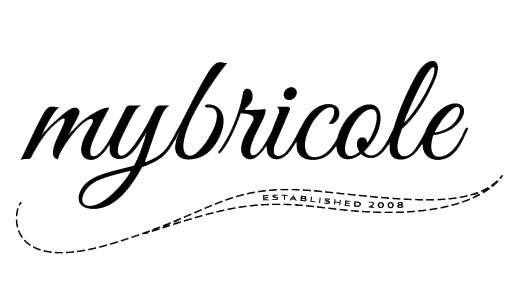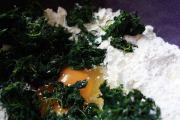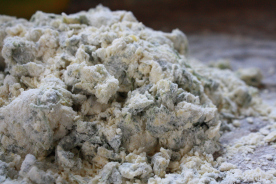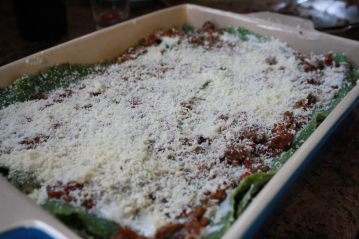Once upon a time there was a girl who was planning her very first dinner party. She set a menu of ricotta ravioli with a fresh tomato sauce. On the side there would be roasted sweet potato and butternut squash with a balsamic sauce and sea salt. Little did she know, she was unable to make pasta. Though she tried and tried, each time she was left with a floury, crumbly mess. That night her friends dined on delivery pizza and roasted sweet potato and butternut squash and it became known as the ravioli incident. Eight years later...
This very same girl has been challenged by Daring Bakers to make lasagne from beginning to end, all by hand. ugh
The March 2009 challenge is hosted by Mary of Beans and Caviar, Melinda of Melbourne Larder and Enza of Io Da Grande. They have chosen Lasagne of Emilia-Romagna from The Splendid Table by Lynne Rossetto Kasper as the challenge.
She gathered up her confindence and took a deep breath...
The recipe that follows is what I used. For the original challenge recipe, be sure to check out the official Daring Bakers site.
spinach egg pasta
makes equivalent of 1 pound of dried pasta
3 eggs (the original recipe said 2 eggs but after my first attempt I needed to add one)
6 ounces frozen chopped spinach, defrosted and squeezed dry
3 1/2 cups all purpose unbleached flour
You can make a well with the flour, but I learned during the ravioli incident that wells and I can't seem to make it work.
Place flour in a bowl and make a little well for the egg and spinach.
Using a fork gradually beat together the eggs and spinach. Then gradually start incorporating shallow scrapings of flour from the sides of the the well into the liquid. As you work more and more flour into the liquid, the well's sides will collapse. Use a pastry scraper to keep the liquids from running off and to incorporate the last bits of flour into the dough. Don't worry if it looks like a hopelessly rough and messy lump
except mine looked like this
I reminded myself to be daring and take another shot at it. I bumped the eggs up to three and this time I didn't squeeze all the water out of the spinach.
AND
look what happened - you can see the color difference between leaving a bit of spinach water instead of really squeezing it dry.
Kneading -
With the aid of a scraper to scoop up unruly pieces, start kneading the dough. Once it becomes a cohesive mass, use the scraper to remove and bits for hard flour on the work surface - these will make the dough lumpy. Knead the dough for about 3 minutes. It's consistency should be elastic and a little sticky. Continue kneading for about 10 minutes, or until the dough has become satiny, smooth, and very elastic. It will feel alive under your hands. Do not shortcut this step. Wrap the dough in plastic wrap and let it relax at room temperature for 30 minutes to 3 hours.
After finding success with the 2nd batch I went back and added another egg to the first and was able to knead it as well.
Stretching and Thinning -
If using a regular rolling pin, divide the dough into quarters. Lightly sprinkle a large work surface with flour. The idea is to stretch the dough rather than press down and push it. Shape it into a ball and begin rolling out to form a circle, frequently turning the disc of dough a quarter turn. As it thins out, start rolling the disc back on the pin a quarter of the way toward the center and stretching it gently sideways by running the palms of your hands over the rolled-up dough from the center of the pin outward. Unroll, turn the disc a quarter turn, and repeat.
Stretch and even out the center of the disc by rolling the dough a quarter of the way back on the pin. Then gently push the rolling pin away from you with one hand while holding the sheet in place on the work surface with the other hand. Repeat three more times, turning the dough a quarter turn each time.
Repeat the two processes as the disc become larger and thinner. The goal is a sheet of even thickness. For lasagne, the sheet should be so thin that you can see your hand through it and colors. Cut into rectangle about 4 x 8 inches. Dry the pasta at room temperature and store in a sealed container or bag.
These were hanging on my bed. They seemed fairly dry at bedtime so I placed them flat on some racks over night. Oops. They had enough moisture in them that they curled. They cooked up without any problems.
country style ragu
Prep time 30 minutes - cooking time 2 hours
3 Tablespoons olive oil
2 ounces pancetta, finely chopped
1 medium onion, minced
1 medium stalk celery, minced
1 small carrot, minced
4 ounces Italian sausage
12 ounces ground chuck
2 ounces finely chopped Porsciutto di Parmi
2/3 cup dry red wine
1 1/2 cups beef stock
2 cups milk
4 roasted Roma tomatoes, chopped
salt and pepper
This sauce can be made 3 days ahead, kept in the fridge, or can be frozen for up to 1 month.
browning the base -
Heat olive oil in large skillet over medium heat. (Have large bowl at hand for when browning is complete) Add pancetta and minced vegetables and saute, stirring frequently for 10 minutes.
Mix all the meats together and stir into the pan. Slowly brown over medium heat. Stir often. Protect the brown glaze forming on the bottom by turning the heat down. Cook 15 minutes, or until the meats are a deep brown.
Reducing and simmering -
Place the brown meats in the bowl and set aside. Add the wine to the skillet, lowering the heat so the sauce bubbles quietly. Stir occasionally until the wine has reduced by half, about 3 minutes. Scrape up the brown glaze as the wine bubbles. Then pour the browned meats back into the skillet.
Stir 1/2 cup stock into the skillet and let bubble slowly, for 10 minutes, or until totally evaporated. Repeat with another 1/2 cup stock. Stir in the last 1/2 cup stock along with the milk. Adjust the heat so the liquid bubbles very slowly. Partially cover the skillet and cook 1 hour. Stir frequently to check for sticking.
Add the tomatoes. Cook uncovered at a very slow bubble for another 45 minutes, or until the sauce resembles a thick, meaty stew. Season with salt and pepper.
bechamel
prep time 15 minutes
4 Tablespoons butter
4 Tablespoons flour
2 2/3 cup milk
salt and pepper
freshly grated nutmeg
Using a medium saucepan, melt the butter over low to medium heat. Sift over the flour, whisk until smooth, and then stir (without stopping) for about 3 minutes. Whisk in the milk a little at a time and keep the mixture smooth. Bring to a slow simmer, and stir 3 to 4 minutes, continue cooking and stirring for about 5 minutes, until the sauce thickens. Season with salt, pepper, and hint of nutmeg.
assembling the lasagne
large pot of water
9 x 13 baking dish
1 recipe spinach pasta
1 recipe bechamel
1 recipe country style ragu
1 1/2 cups freshly grated Parmigiano-Reggiano
Bring a large pot of salted water to a boil. Drop about 4 pieces of pasta in the water at a time. Cook about 2 minutes for fresh pasta, 4 minutes if you have dried it. The pasta will continue cooking during baking, so make sure it is only barely tender. Lift the lasagne from the water with a skimmer, drain, and then slip into the bowl of cold water to stop cooking. When cooled, lift out and dry on a layer of towels. Repeat until all the pasta is cooked.
To assemble, spread a thin layer of bechamel over the bottom of the baking dish. Arrange a layer of overlapping sheets of pasta over the bechamel. Spread a thing layer of bechamel (about 3 - 4 spoonfuls) over the pasta, and then an equally thin layer of ragu.
Sprinkle with layer of grated cheese. Repeat until all ingredients are used, finishing with bechamel sauce and topping with a generous dusting of cheese.
I had enough of each of the sauces to do 8 layers.
Baking and serving -
Cover the baking dish lightly with foil, taking care not to let it touch the top of the lasagne. Bake 40 minutes, or until almost heated through. Remove the foil and bake another 10 minutes, or until hot in the center (test by inserting a knife - if it comes out very warm, the dish is ready). Take care not to brown the cheese topping, It should be melted, creamy looking and barely tinged with a little gold. Turn off the oven, leave the door ajar and let the lasagne rest for about 10 minutes. Then serve. This is not a solid lasagne, but a moist one that slips a bit when it is cut and served.
The lasagne was enjoyed by the girl and her spouse.
It was declared throughout the land that not only could the girl make pasta, but she had made the best lasagne that either of them had ever eaten.
And they all lived...















